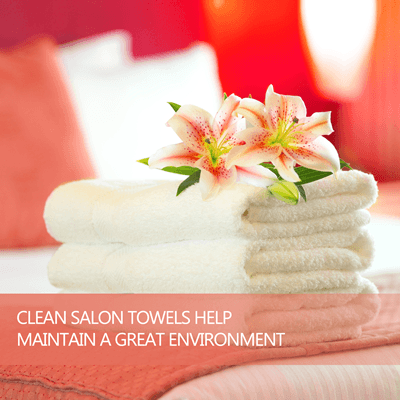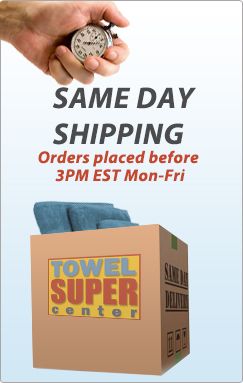How to Eliminate Germs & Contaminants in Your Salon
- Created: Friday, 24 April 2015 15:02
Clients know there’s a good chance of visiting a salon and leaving with more than a manicure, pedicure or new hairstyle. They could also leave with germs that may eventually cause a terrible infection. Unfortunately, people don’t associate salon germs with just a particular salon, but rather all of them. In fact, you’ve probably been interrogated a couple times about your cleaning practices after a disease outbreak at another salon. This makes acquiring new business and keeping existing clients tough for an already busy salon owner like you.
Thankfully, you have a tough secret weapon to fight these germs and keep clients safe: salon towels. You’re probably thinking: “I already use more towels every day than most businesses in Los Angeles.” You’re right. You probably do.
However, answer the following questions:
- Are your employees spreading germs by mistake?
- Do you sanitize salon towels correctly?
- Do you even use towels for salons?

Germs Found in Towels
Before discussing towels for salons that double as germ fighters when used correctly, let’s focus on germs found in towels. Most people think germs are just bugs or gross stuff you can see. Germs are something more. They are actually small, living organisms.
The problem for salon owners is the disease-causing germs are so tiny that they can’t be seen. This allows germs to live in towels and creep into clients’ bodies. Suddenly, there’s an infection outbreak at your salon. Germs have just eliminated most of your business.
Bacteria
Bacteria are single-celled organisms that reproduce quickly. Just one bacterium can become one billion in 10 hours. Most of the germs on towels come from a person’s body. While it’s common to have bacteria on the surface of skin — many different types of bacteria are harmless — other bacteria living on towels can infect you, your clients and employees.
The following germs are a sample of what lives on towels:
Staph Infection
Methicillin-resistant Staphylococcus aureus, also known as MRSA, is a bacterium difficult to cure. The infection resists most antibiotics created to kill it. The germ is transferred in two ways: person-to-person contact and touching a contaminated object such as a towel.
A MRSA infection presents typically like a pimple, bite or spider bite. It produces red, painful, swollen lumps, filled with pus. The bacteria usually appears on areas where skin is broken, cut or scraped, such as:
- Back of a person’s neck
- Buttock
- Groin
- Armpit
- Beard area
Pink Eye
Conjunctivitis, also known as pink eye, is an infection of the lines located on the inside of the eyelid. It also affects the white part of the eyeball. The “lines” are called conjunctiva.
Trichomoniasis
Trichomoniasis, which is actually a parasite, is typically passed from person to person via sexual contact. Unfortunately, towels can be third-party carriers of the organism. In women, it causes a foul-smelling, vaginal discharge, painful urination and genital itching. Men generally have no symptoms. The incubation period of 28 days is a guesstimate.
Fungi
Fungi is a different type of germ. It is a microscopic organism that can beneficial or harmful to people. Fungi are multi-cell and plant-like organisms that feed off of people, plants and animals. They don’t need sunlight to stay alive — in fact, they thrive in dark, damp places. Various types of fungi can live on towels, including:
Athlete’s Foot — Athlete’s foot is a gross fungal infection that starts between the toes and spreads to the rest of the foot. The rash burns, itches and stings. The fungus is not only spread via contaminated towels, but also from contact with contaminated floors and clothing. Athlete’s foot is one of the top diseases clients “pick up” at nail salons.
Dermatophyte Fungus — Dermatophyte fungus is commonly known as nail fungus.
Viruses
Viruses, which are smaller than bacterium, are another type of germ. Another difference is the germ can’t reproduce or grow away from a living cell. A virus invades the body via contact with an infected person and through use of contaminated objects. Unfortunately, viruses change from person to person, which makes curing the virus hard for healthcare professionals. Some viruses that live on towels include:
- Human Papillomavirus — Human papillomavirus, or HPV, is a contagious skin disease with different strains. You may be familiar with the term because it causes cervical cancer. Most of the time the virus causes warts.
- H1N1 — H1N1 is commonly called swine flu. This is a highly contagious flu virus. Why? Most people haven’t built up immunity to the virus. Swine flu infects your clients when an infected person sneezes, touches their mouths or coughs. The virus lives outside the body for about eight hours. This means it can be on a dirty towel in your salon for eight hours, waiting to infect someone.
- Mycobacterium fortuitum — A M. fortuitum creates large boils on the leg, toes or foot. The large boil may be surrounded by tiny bumps. It’s commonly contracted during a foot bath.
Are You or Your Employees Spreading Germs?
Spreading germs are easy to do. It’s busy. The towels have finished drying, but no one has collected them from the dryer. One employee decides to collect the towels because you’re running out of them. She leaves her booth, opens the dryer and grabs the towels. She folds them. She’s even nice enough to hand them out to other employees.
What’s the problem?
She didn’t wash her hands.
Maybe she styled someone’s hair. Maybe she gave a client a manicure or pedicure. Maybe she was greeting customers. Maybe she hung up someone’s coat. Maybe she thought “it’s just towels, and my hands aren’t that dirty.”
Hairdressers, makeup artists, barbers and beauticians all must wash their hands before and after working with clients. Hands come in contact with a lot of germs throughout the day. In fact, they are the biggest risk to keeping a salon germ-free.
There are other places germs rest in your salon before traveling home with clients, such as:
Salon Couches and Chairs
One drop of blood infected with Hepatitis lands on your salon chair. You can’t see the blood drop, but it’s there. It remains on the chair for several days. There’s a chance someone has a scrape or cut not covered by a bandage on his or her arm. Fortunately, the chance of cross-infection is tiny. Unfortunately, cross-infection is still possible.
Most of the salon furniture is made from vinyl or PVC. This makes the furniture easy to clean. However, using the wrong product can make the vinyl or PVC crack or become brittle. Disinfectant containing ethanol should be avoided like your worst enemy since it causes the furniture to crack or become brittle. Once the surface is cracked, germs start seeping into the furniture and multiplying.
Foot Baths
Foot baths, such as whirlpools, are where bacterium and fungi cohabitate and multiple including:
- HPV
- Mycobacterium
- Warts
- Toenail fungus
- Athlete’s foot
- MRSA
- Swine flu
All of the germs thrive in wet, warm environments, making foot baths the “perfect” place to hide. The problem is whirlpools are hard to quickly clean.
Cluttered Workstations
Cluttered workstations are another breeding ground for germs. Piles of used towels, scrub brushes and trays at a workstation do not only scream “super busy area,” they also scream “germ amusement park.” Items can easily become cross-contaminated. This means an employee is one step closer to driving away clients.
Contaminated Tools and Instruments
You and your employees know about keeping instruments and tools sterilized between clients. A lot of advanced products make sanitizing tools quick, easy and cost-effective. However, taking short cuts can cause germs to spread.
Why?
Any time organic matter is left on tools, the disinfecting process slows down. Let’s say you only need to place tools in a sanitizing solution for 20 minutes. You do that, but don’t properly clean the instruments with towels for salons. Debris is still on the tools. The sanitation solution needs longer than 20 minutes to properly sanitize them. So the tools can still be germ-infested when you remove them from the solution at the required time.
Improperly Sanitized Floors
Floors are one of the places fungi thrive. So keep the floor and all other hard surfaces clean with a quality floor disinfectant.
Keeping You Safe and Germ-Free Starts With Salon Towels
With all the germs living in and around the salon, you may be tempted to charge them rent. Look on the bright side: You have salon towels. Nail salon towels and hair salon towels are perfect ways to sanitize salons when used correctly. For instance, you should follow these guidelines when using salon towels:
- Never reuse a salon towel. Repeated use of the any towel can contaminate you, your employee and clients.
- Never leave wet, dirty towels on the floor or work area. Not only does it look unsanitary, it can also spread germs from one area to another.
- Add at least a 3/4 cup of regular chlorine bleach when washing the towels. In fact, you should use bleach regularly in the towel wash.
- Add vinegar to remove odors, which will also get rid of some germs on the dirty towels.
- Place the laundry setting on high. You want it at least 155 degrees Fahrenheit. The heat kills a lot of germs on the towels.
- Remove clean towels from the dryer only when they are completely dry.
- Use a color-coded system for each employee to reduce the spread of germs. For instance, you may want your nail technicians to use blue nail salon towels. You may instruct you hairstylists to red hair salon towels.
How Do You Keep Your Salon Towels From Deteriorating When Using so Much Bleach?
 Use color-safe towels for salons that are bleach resistant. Color-safe, bleach-resistant towels from Towel Super Center are great for multiple washings.
Use color-safe towels for salons that are bleach resistant. Color-safe, bleach-resistant towels from Towel Super Center are great for multiple washings.
Why?
- They withstand the exposure to harsh chemicals such as bleach.
- They are high-quality towels that stay fluffy.
- They are absorbent.
- They are saturated with color. Thus, they aren’t going to lose the richness of color just because they are exposed to bleach.
Always Perform a Final Check to Keep Your Salon Germ-Free
Cleaning is a daunting and tiresome chore at a salon. A checklist can often make it easier to clean and eliminate or reduce germs. Here are some things you can do:
Conduct an Overall Inspection
Walk into your salon like you are a new client or state board inspector. You want to look for things that are wrong. Inspect the:
- Counters
- Floors
- Walls
- Displays
You want all three to be free of smudges, dust and smears. Look on the floor for hair. Make sure to inspect the corners.
Next, look at the booths, chairs and couches. They should be in good shape, free of any cracks.
Pay attention to any dirty towels. They shouldn’t be on the floor or table, but rather in a closed towel container. Clean towels should be inside a closed cabinet.
Search for any debris or trash. These two items are a turn-off for new clients.

Sanitize everything a client and employee touches such as:
- Combs
- Brushes
- Nail instruments
- Clippers
- Rollers
Shampoo towels must always be sanitized between uses with a fresh, clean towel.
Sterilize all drinking cups between uses.
Clean and sanitize with soap and water first:
- Metal cuticle pushers
- Foot spas
- Nail clippers
Then, use disinfectant to clean and sanitize them again. Place them in a covered container with disinfectant.
Place dirty tools in a container marked “dirty.”
Clean all surfaces, such as counters, with disinfectant about every 15 minutes. Only wipe dry with a clean, dry towel.
Keep a logbook of each time things are cleaned and sanitized.
At the end of each workday, the closing staff must go over their own checklist. The checklist covers what should be sanitized before leaving. Your employee should sign off on the inspection checklist. You or someone on the morning staff should walk through to make sure each item on the list was cleaned and sanitized.
Invest in Color Safe, Bleach-resistant Salon Towels from Towel Super Center
As a busy salon owner, keeping your clients safe is at the forefront of your business. Following safe cleaning practices, washing towels correctly and creating a cleaning checklist are some ways to keep germs away. Another way is using high-quality nail salon towels and hair salon towels.
Investing in quality salon towels is one way to keep your clients safe. Towel Super Center has the high-quality, bleach-resistant towels for your salon. We offer towels made from 100 percent terry cloth. You can pick from a variety of sizes depending on your business needs. They are ideal for drying, cleaning and absorbing.
We also offer a huge selection of colors to suit your salon’s aesthetic needs. In other words, you never have to be stuck with all white salon towels. Remember, our towels are bleach-proof, making them tough towels ideal for salons.
So when you want towels for salons that can stand the test of time, buy our salon towels.





